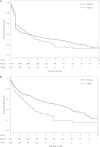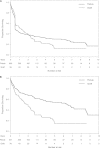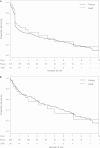Cumulative patency of contemporary fistulas versus grafts (2000-2010)
- PMID: 23371955
- PMCID: PMC3641610
- DOI: 10.2215/CJN.00730112
Cumulative patency of contemporary fistulas versus grafts (2000-2010)
Abstract
Background and objectives: Comparisons of fistulas and grafts often overlook the high primary failure rate of fistulas. This study compared cumulative patency (time from access creation to permanent failure) of fistulas and grafts.
Design, setting, participants, & measurements: Vascular accesses of 1140 hemodialysis patients from two centers (Toronto and London, Ontario, Canada, 2000-2010) were analyzed. Cumulative patency was compared between groups using Kaplan-Meier survival curves and log-rank tests. Hazard ratios (HRs) for fistula failure relative to grafts and 95% confidence intervals (95% CIs) are reported.
Results: There were 1012 (88.8%) fistulas and 128 (11.2%) grafts. The primary failure rate was two times greater for fistulas than for grafts: 40% versus 19% (P<0.001). Cumulative patency did not differ between fistulas and grafts for the patients' first access (median, 7.4 versus 15.0 months, respectively [HR, 0.99; 95% CI, 0.79-1.23; P=0.85]) or for 600 with a subsequent access (7.0 versus 9.0 months [HR, 0.93; 95% CI, 0.77-1.13; P=0.39]). However, when primary failures were excluded, cumulative patency became significantly longer for fistulas than for grafts for both first and subsequent accesses (61.9 versus 23.8 months [HR, 0.56; 95% CI, 0.43-0.74; P<0.001] and 42.8 versus 15.9 months [HR, 0.56; 95% CI, 0.44-0.72; P<0.001]). Results were similar for forearm and upper-arm accesses. Compared with functioning fistulas, grafts necessitated twice as many angioplasties (1.4 versus 3.2/1000 days, respectively; P<0.001) and significantly more thrombolysis interventions (0.06 versus 0.98/1000 days; P<0.001) to maintain patency once matured and successfully used for dialysis.
Conclusions: Cumulative patency did not differ between fistulas and grafts; however, grafts necessitated more interventions to maintain functional patency.
Figures



Comment in
-
Lifting the veil: insights into vascular access options.Clin J Am Soc Nephrol. 2013 May;8(5):708-10. doi: 10.2215/CJN.03070313. Epub 2013 Apr 18. Clin J Am Soc Nephrol. 2013. PMID: 23599407 No abstract available.
References
-
- Fistula First National Vascular Access Improvements Initiative. Available at: http://www.fistulafirst.org/ 2011. Accessed September 9, 2011.
-
- Tonnessen BH, Money SR: Embracing the fistula first national vascular access improvement initiative. J Vasc Surg 42: 585–586, 2005 - PubMed
-
- National Kidney Foundation-Dialysis Outcomes Quality Initiative : NKF-DOQI clinical practice guidelines for vascular access. Am J Kidney Dis 30[Suppl 3]: S150–S191, 1997 - PubMed
-
- III : III. NKF-K/DOQI Clinical Practice Guidelines for Vascular Access: update 2000. Am J Kidney Dis 37[Suppl 1]: S137–S181, 2001 - PubMed
-
- Jindal K, Chan CT, Deziel C, Hirsch D, Soroka SD, Tonelli M, Culleton BF: Hemodialysis clinical practice guidelines for the Canadian Society of Nephrology. Chapter four: Vascular access. J Am Soc Nephrol 17: S16–S23, 2006 - PubMed
Publication types
MeSH terms
LinkOut - more resources
Full Text Sources
Other Literature Sources
Medical

